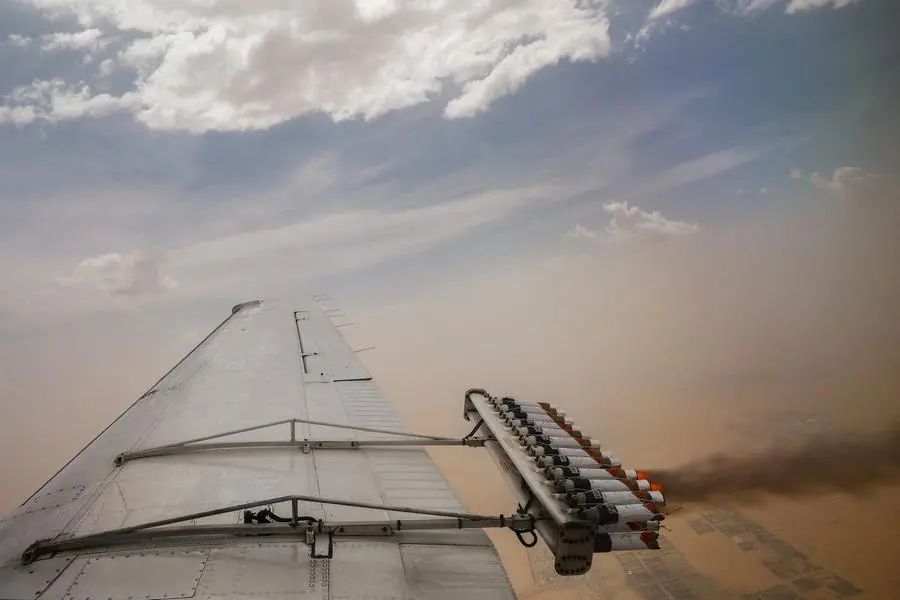PHOTO
The initial cloud seeding attempt in the country took place in 1982 as a trial lasting for two months
The UAE, on an average, conducts over 900 hours of cloud-seeding missions every year with the government making substantial investments in research and technology.
Launched by the Ministry of Presidential Affairs of the UAE and managed by the National Centre of Meteorology (NCM), the UAE Research Programme for Rain Enhancement Science is an ambitious initiative of global scope designed to stimulate rain enhancement research and improve water security.
The country has also partnered with international organisations and experts in the field to improve their cloud seeding capabilities.
Khaleej Times delves deeper into the subject to understand how these missions are conducted and have reported positive outcomes, with increased rainfall in specific areas after cloud seeding operations.
Here are the excerpts of an exclusive interview with the UAE’ National Centre of Meteorology (NCM).
How is cloud seeding done in the UAE?
In the UAE, cloud seeding is a meticulously organised procedure carried out by meteorologists and specialists from the National Centre of Meteorology (NCM). This process comprises of various stages, including weather analysis, planning, execution, and monitoring.
Special flares containing nucleating agents are released into clouds during cloud seeding. This encourages the droplets within the clouds to increase in size until they become sufficiently heavy to fall as precipitation.
What are the different methods used for cloud seeding?
Across the globe, multiple methods are used for cloud seeding depending on various factors, including the specific weather conditions, the type of clouds targeted, and the desired outcomes.
In the UAE, environmentally friendly hygroscopic materials are commonly used for cloud seeding. These materials contain natural salts, including potassium chloride and sodium chloride, and are typically delivered into clouds via flares.
Generally, there are three different tools to deliver the seeding agents, using aircraft or rockets and ground generators, in the UAE we use airplanes and ground generators based on high leveled ground
What is the duration of a cloud seeding mission?
The duration of a cloud seeding missions can vary significantly depending on several factors, including the weather conditions, the type of clouds being seeded, and the specific objectives of the cloud seeding operation.
In the UAE, a typical cloud seeding mission may last for 3 hours and is usually conducted when suitable cloud formations are present.
What kinds of jets go up for these missions and what are they equipped with?
The cloud seeding missions in the UAE are conducted using four custom-designed Beechcraft King Air aircraft. The four aircrafts have especially been equipped at the NCM for cloud seeding operations and are an essential part of the cloud-seeding program.
These aircrafts have a holding rack designed to transport cloud-seeding flares and canisters. Only trained pilots operate these aircraft in collaboration with meteorologists and cloud-seeding experts to execute the missions.
The aircrafts are part of NCM’s comprehensive meteorological infrastructure that includes an extensive network of more than 95 weather stations, and an integrated radar network to support the missions.
The pyro technique flares and seeding agents that are used
The pyrotechnic flares used in cloud seeding typically contain seeding agents, such as hygroscopic materials that can activate the condensation process and to promote the microphysical processes such as the collision and coalescence processes to enlarge cloud droplets.
These flares are ignited and released from aircraft or ground-based generators, and as they burn, they disperse the seeding agents into the target clouds. Once released into the clouds, these seeding agents can influence the cloud microphysics and potentially enhance precipitation.
Is cloud seeding a reliable method for weather modification?
The statistical randomisation experiments and field tests conducted by the United Arab Emirates Research Program for Rain Enhancement Science (UAEREP) have demonstrated that cloud seeding is a reliable method for weather modification, yielding positive results in enhancing precipitation and addressing water scarcity challenges in arid regions.
However, the success of cloud seeding depends on several factors, including the type of seeding materials used, atmospheric conditions, and the expertise of the meteorologists and specialists involved in planning and executing the missions. The effectiveness of cloud seeding can also vary depending on local conditions and the specific goals of the program. The ongoing research and advancements are continually enhancing its reliability and effectiveness.
When did cloud seeding missions begin in the UAE?
The initial cloud seeding attempt took place in 1982 as a trial lasting for two months. Following that, cloud seeding operations have been carried out annually, but without a strong scientific foundation. By the end of 1990, the government established advanced facilities to address water security challenges in collaboration with prestigious institutions such as the National Center for Atmospheric Research (NCAR) in Colorado, USA, Witwatersrand University in South Africa, and NASA, US space agency.
This collaboration continued until 2003, with a focus on researching the chemical and physical properties of common and amenable clouds suitable for seeding. The primary objective was to determine the appropriate materials to introduce into the clouds to ensure successful rain enhancement.
In 2015, the UAEREP was launched as an international research initiative dedicated to advancing the science, technology, and implementation of rain enhancement. Besides fostering global research funding and partnerships, the program aims to boost rainfall not only in the UAE but also in other arid and semi-arid regions.
Copyright © 2022 Khaleej Times. All Rights Reserved. Provided by SyndiGate Media Inc. (Syndigate.info).




















